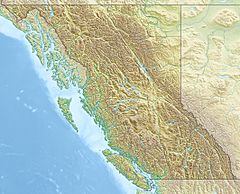Yak Peak facts for kids
Quick facts for kids Yak Peak |
|
|---|---|

Yak Peak from Needle Peak
|
|
| Highest point | |
| Elevation | 2,039 m (6,690 ft) |
| Prominence | 500 m (1,600 ft) |
| Parent peak | Vicuna Peak (2126 m) |
| Geography | |
| Parent range | Canadian Cascades |
| Topo map | NTS 92H/11 |
| Climbing | |
| First ascent | Possibly C.E. Cairnes or George Dawson c. 1906 |
| Easiest route | Scramble via the NE Ridge |
Yak Peak is a tall mountain made of strong granite rock in British Columbia, Canada. It's located very close to the Coquihalla Highway, just north of a town called Hope. You can easily spot this mountain from many parts of the highway, especially near the rest areas and old tollbooths.
Yak Peak is well-known for its excellent rock climbing paths, with a famous one called Yak Crack. This mountain is part of a group of peaks often called the Anderson River Group or the Coquihalla Range. Other mountains in this group have names like animals, such as Thar Peak and Guanaco Peak.
Understanding Yak Peak's Climate
Yak Peak is in a part of western North America that has a marine west coast climate. This means it gets a lot of rain and snow. Most of the weather systems, which are like big air masses, start over the Pacific Ocean. As these weather systems move east, they hit the Cascade Range mountains. The mountains force the air to rise. When the air rises, it cools down and drops its moisture as rain or snow. This process is called orographic lift.
Because of this, the Cascade Mountains, including Yak Peak, get a lot of precipitation, especially during the winter months when there's heavy snowfall. Temperatures can get very cold, sometimes dropping below −20 °C (that's −4 °F) with the wind making it feel even colder, below −30 °C (which is −22 °F). If you want to climb Yak Peak, the best time to visit is usually from July through September, when the weather is much nicer and warmer.
Images for kids



